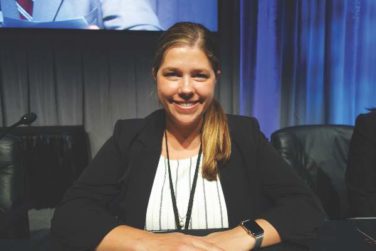Formerly known as A-101, Eskata is a novel topical treatment for seborrheic keratoses (SKs) that was approved by the Food and Drug Administration in December 2017. It is a 40% hydrogen peroxide topical solution that is applied to raised SKs as an in-office procedure. As previously reported, SKs are composed of hyperadherent senescent cells that are arrested in the G1 phase of the cell cycle. They exhibit decreased apoptotic cell death, compared with normal skin.
While the mechanism of action of Eskata is unknown, highly reactive oxygen species likely created from application of this concentration of hydrogen peroxide may lead to direct oxidative damage to SK cells. The oxidative damage created can induce local protein, lipid, and membrane peroxidation, and ultimately, necrotic and apoptotic cell death of the SK cells.
Two double-blind vehicle-controlled studies demonstrated that more patients were clear or near clear of SKs after use of the 40% concentration solution than those in the vehicle group, according to the prescribing information . In the studies, patients with four raised SKs of the face, trunk or extremities were treated with Eskata at baseline and 3 weeks later, if necessary, or a vehicle. None of those in the vehicle group were cleared at follow-up (day 106), compared with 4% and 8% of those treated with Eskata, and at least three of the four lesions treated with Eskata had cleared in 13% and 23% at follow-up. Local skin reactions were mostly mild and transient, the most common being itching, stinging, crusting, swelling, redness, and scaling at the application site.
Like other treatments for SKs, these reactions may begin within 10 minutes, and it may take 1-2 weeks for the lesion to resolve.
In the clinical studies, the solution was applied up to two times, on day 0 and again 3 weeks later on day 22. The lesion should first be cleansed with alcohol, and appropriate measures should be taken to ensure Eskata does not come in contact with the eyes. Nitrile or vinyl examination gloves should be used for application. Eskata is applied to the SKs with a pen-like applicator. The solution is applied uniformly in a circular motion with excess and the surrounding area patted dry with an absorbent wipe. Cotton gauze, tips, paper towels, or tissue should not be used as organic compounds can react with high concentrations of hydrogen peroxide. In a treatment session, one lesion may be treated up to four times, 1 minute apart. The applicator is used only once and may be discarded after lesions are treated. The packages may be stored at controlled room temperature (68° F to 77° F).
Current therapies for SKs include cryotherapy, electrodessication, curettage, shave biopsy/removal, and laser therapy. As SKs affect at least 83 million Americans and are bothersome to patients because of cosmetic disfigurement, irritation, unnecessary diagnostic biopsies, or annoyance, this novel therapy provides a noninvasive treatment option with the potential to supersede all prior therapies with less pain and risk of pigmentary alteration and scarring from the procedure. It is expected to be commercially available in the spring of 2018.
Dr. Wesley and Dr. Talakoub are cocontributors to this column. Dr. Wesley practices dermatology in Beverly Hills, Calif. Dr. Talakoub is in private practice in McLean, Va. This month’s column is by Dr. Wesley. Dr. Wesley has served on an advisory board panel for Aclaris, the manufacturer of Eskata. Dr. Talakoub had no related disclosures. Write to them at dermnews@frontlinemedcom.com .




